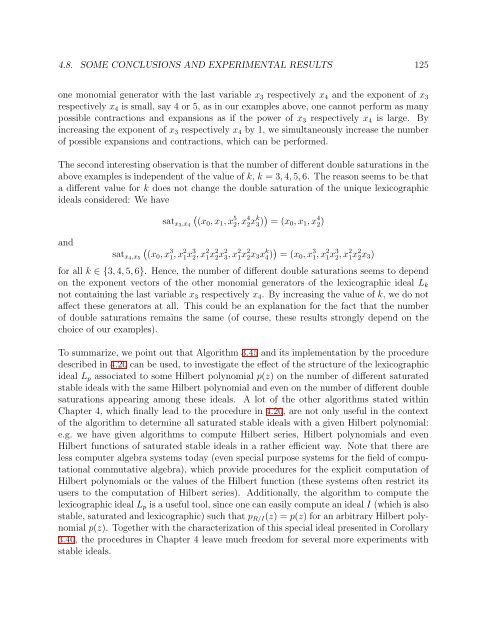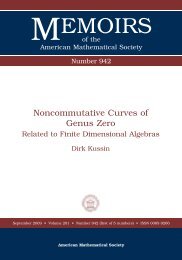University of Paderborn Department of Mathematics Diploma Thesis ...
University of Paderborn Department of Mathematics Diploma Thesis ...
University of Paderborn Department of Mathematics Diploma Thesis ...
You also want an ePaper? Increase the reach of your titles
YUMPU automatically turns print PDFs into web optimized ePapers that Google loves.
4.8. SOME CONCLUSIONS AND EXPERIMENTAL RESULTS 125one monomial generator with the last variable x 3 respectively x 4 and the exponent <strong>of</strong> x 3respectively x 4 is small, say 4 or 5, as in our examples above, one cannot perform as manypossible contractions and expansions as if the power <strong>of</strong> x 3 respectively x 4 is large. Byincreasing the exponent <strong>of</strong> x 3 respectively x 4 by 1, we simultaneously increase the number<strong>of</strong> possible expansions and contractions, which can be performed.The second interesting observation is that the number <strong>of</strong> different double saturations in theabove examples is independent <strong>of</strong> the value <strong>of</strong> k, k = 3, 4, 5, 6. The reason seems to be thata different value for k does not change the double saturation <strong>of</strong> the unique lexicographicideals considered: We haveandsat x3 ,x 4((x0 , x 1 , x 5 2, x 4 2x k 3) ) = (x 0 , x 1 , x 4 2)sat x4 ,x 5((x0 , x 3 1, x 2 1x 3 2, x 2 1x 2 2x 2 3, x 2 1x 2 2x 3 x k 4) ) = (x 0 , x 3 1, x 2 1x 3 2, x 2 1x 2 2x 3 )for all k ∈ {3, 4, 5, 6}. Hence, the number <strong>of</strong> different double saturations seems to dependon the exponent vectors <strong>of</strong> the other monomial generators <strong>of</strong> the lexicographic ideal L knot containing the last variable x 3 respectively x 4 . By increasing the value <strong>of</strong> k, we do notaffect these generators at all. This could be an explanation for the fact that the number<strong>of</strong> double saturations remains the same (<strong>of</strong> course, these results strongly depend on thechoice <strong>of</strong> our examples).To summarize, we point out that Algorithm 3.45 and its implementation by the proceduredescribed in 4.20 can be used, to investigate the effect <strong>of</strong> the structure <strong>of</strong> the lexicographicideal L p associated to some Hilbert polynomial p(z) on the number <strong>of</strong> different saturatedstable ideals with the same Hilbert polynomial and even on the number <strong>of</strong> different doublesaturations appearing among these ideals. A lot <strong>of</strong> the other algorithms stated withinChapter 4, which finally lead to the procedure in 4.20, are not only useful in the context<strong>of</strong> the algorithm to determine all saturated stable ideals with a given Hilbert polynomial:e.g. we have given algorithms to compute Hilbert series, Hilbert polynomials and evenHilbert functions <strong>of</strong> saturated stable ideals in a rather efficient way. Note that there areless computer algebra systems today (even special purpose systems for the field <strong>of</strong> computationalcommutative algebra), which provide procedures for the explicit computation <strong>of</strong>Hilbert polynomials or the values <strong>of</strong> the Hilbert function (these systems <strong>of</strong>ten restrict itsusers to the computation <strong>of</strong> Hilbert series). Additionally, the algorithm to compute thelexicographic ideal L p is a useful tool, since one can easily compute an ideal I (which is alsostable, saturated and lexicographic) such that p R/I (z) = p(z) for an arbitrary Hilbert polynomialp(z). Together with the characterization <strong>of</strong> this special ideal presented in Corollary3.40, the procedures in Chapter 4 leave much freedom for several more experiments withstable ideals.
















